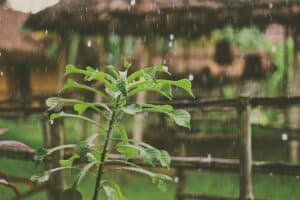We don’t know if you’ve noticed, but this year the summer has been a bit… absent. We’ve had patches of that glorious sunshine you’d expect between June and September, but for the most part, this summer has been cool and damp. Very damp. In fact, 2023 saw the wettest July on record (with records going back to 1891)!
With all this water around, you might have noticed that your garden doesn’t look the same as it normally would in summer. Weird weather can have a significant impact on the growth patterns in your garden and on commercial grounds as well, so today we’re going to explain what’s going on, and how you can protect your greenery.
Explosive, Yet Small, Growth
When the weather gets really wet and really cool compared to normal, trees and shrubs have plenty of water to fill their expanding leaves and blossoms. But because the temperature has been lower than normal they haven’t been able to get enough nutrition from photosynthesis to grow big. So you might see a lot of new growth on trees and evergreen shrubs, but when you look closer the new leaves will probably be quite small! The bad news is they are likely to stay that way as well, because once the leaves begin to lay down cuticle, they don’t expand any longer, even if the weather gets warmer. It’s not going to harm your plants in any way, but they might look a bit different this year!
Drowning Plants
Despite the fact they need it to live, there is such a thing as too much water for plants. Just as we can drown despite being 60% water, plants and trees can suffer from overwatering. Plants that grow in soil that’s too wet can become starved of oxygen, which leads to the death of the roots and a general wilting in the plant itself. When we go through periods of high rain, soil can become easily waterlogged and prevent the roots of the plant from taking in gasses, slowly suffocating it. There are a few ways you can prevent your soil from waterlogging, including aerating the soil by breaking it up with a garden fork, improving drainage and making sure you have water buts and clear guttering to prevent flooding.
LOTS Of Flowers
In the normal run of things, summer would be the time that worker bees are busy collecting nectar and pollen from flowers, boosting their stores for winter and feeding their queen so that she can reproduce. While they do this, they’re spreading pollen from flowers around, helping flowers become more abundant. This cycle happens every year, and it’s what both species rely on to survive.
The extra rain has thrown a lot of the systems out of whack, but in a good way. Mature fruit trees need a good supply of water to stay healthy, especially during the spring and summer months. The larger the tree and the more leaves it has, the more water is it going to lose and the more nutrients it needs to grow flowers and eventually fruit. Since nutrients are mainly taken up through the roots, and dissolved in water, the more water these trees can get, the better! During summer months tress usually struggle to get the nutrition they need, but with the wet weather, many are producing more blooms than ever before.
 No Leaves… Yet
No Leaves… Yet
One thing that most people don’t think about when it comes to wet summers is the impact it has on leaves. More specifically, on leaf fall. When we have hot summers, the leaves on trees will fall earlier in the year, but when it’s wet, they will fall much later. So this year you’ll probably see your trees staying greener for longer, and then be hit with a flurry of falling leaves in a very short space of time. This means it’s even more important than ever that you have a plan to deal with leaves, their clearance and disposal ahead of time. Especially if you run a business park or commercial premises, where leaves can become a big health and safety issue.
At Pod Landscapes we provide flexible grounds maintenance services for large garden and commercial grounds. Even if the weather isn’t acting the way it should be, we can adjust our maintenance plans around it, providing your grounds exactly what they need to thrive. If you’d like to know more about how the weather affects your garden and grounds, or just want some advice, we’d be happy to help. Just get in touch with one of our team for your free, no-obligation consultation.

 No Leaves… Yet
No Leaves… Yet